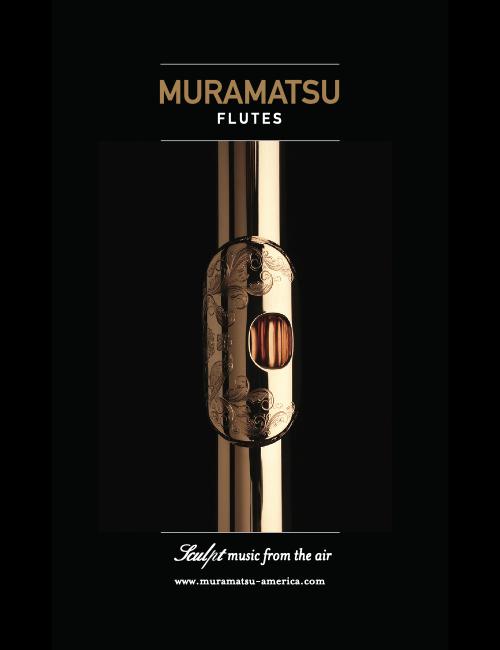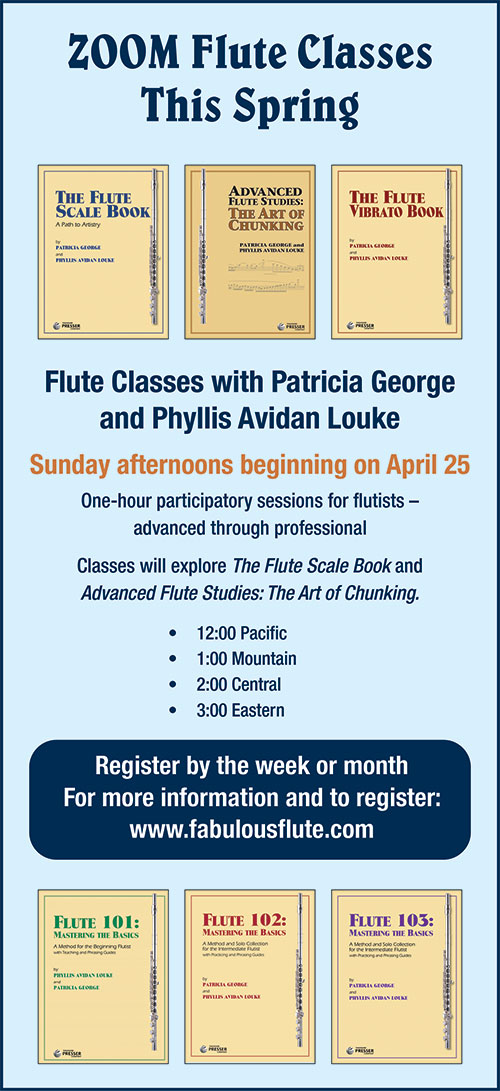Harmonics
Beginning practice with harmonics is an excellent idea as it reminds the flutist how the flute overblows to the upper partials. Harmonics also help set the embouchure for the golden notes – those in the upper middle octave. Georges Barrère suggested using the setting of the third harmonic partial for the all-purpose embouchure. The English flutist Geoffrey Gilbert recommended something quite similar in using one of the middle octave left-hand notes (G, A, or B) to set the embouchure. Usually, flutists practice harmonics low to high, but what if for this month, you switched to practicing them high to low? This is more difficult because your ear has to remember what the top pitch sounds like and what the position of the lips has to be in to be successful.
From The Flute Scale Book by Patricia George & Phyllis Avidan Louke, Published by Presser, Chapter 3.


De la Sonorite
The first exercise in this book by Marcel Moyse is a go to for most flutists. Rather than playing it as written, what about playing it as a third harmonic partial? To do this, finger a low E to a D# overblowing for the B and A#. Michel Debost said that Moyse always intended this exercise to be played with vibrato. Playing vibrato cycles on a harmonic note offers resistance; however, when followed with the notes with the regular fingerings, the vibrato is free and spinning. Play the first pair of notes at the harmonic and on the repeat with the regular fingering. On the descending part of this exercise, the F# (overblown from the low B) is the last of this exercise you can play at the harmonic. Remember to repeat this idea when playing the ascending part of this exercise.
Marcel Moyse: De la Sonorite

Five-note patterns
Rather than starting the five-note patterns on the low D as it is written in 17 Big Daily Exercises by Taffanel & Gaubert, start at the top of the flute on a G ascending to the top D and back down. Then repeat starting on each chromatic note until reaching low C. Doing this with the HAH or breath attack certainly gets the air moving on a lazy day.
From The Flute Scale Book by Patricia George & Phyllis Avidan Louke, Published by Presser, Chapter 5.
.jpg)
Scales
There are so many ways to play scales yet we always start on middle C on the piano. This is a good idea if we were pianists because C major has no sharps or flats. For the flutist starting on low C means that the right-hand pinkie is out of the position of function and having the finger in this position adds tension to the right hand, arm, shoulder etc. Why not start the scale cycle on F major or on G major where the flute is better balanced in the hand and then progressing around the Circle of Fifths practicing C major last in the cycle? I usually start in F major and progress major/minor around the circle of fifths ending with C major and a minor.
Top Octave
We all avoid practicing in the top octave if possible. The fingerings are awkward, and they take a lot of air and a smaller aperture. To overcome avoidance of the issue, I remind myself that today’s high notes will be tomorrow’s low notes. Daily practice of a one octave chromatic scale from D6 to D7 up and down reaps many benefits. Start slowly with the metronome and try to increase the speed a little each week. Becoming more familiar with the fingering combinations means that those top octave passages in repertoire become easier and controllable.
Vibrato and Articulation
Using a hymnal, play the soprano line of a few hymns each day with measured or counted vibrato. To prepare for accurate vibrato cycles, tongue each quarter four times, a dotted quarter six times etc. using first T, then K, then HAH and finally with vibrato cycles. This exercise keeps the vibrato and articulation even and under control. This exercise also improves the technique of moving fingers up and down exactly in time because of the counting of the subdivisions with the metronome.

Etudes
The etudes of Ernesto Kohler are some of the best written for the flute; but most of us are only familiar with the first set in his Op. 33. Check out www.imslp.org for other opuses such as Op. 75, 30, 82, 89, 66, and 60. Download and play away. You will soon figure out that Kohler has one zinging part (chromatic major seconds at a fast tempo) in each etude that will need a little bit of extra attention. Figuring out the best grouping and chunking solutions to play these few measures is quite beneficial to your entire approach to music.
Coda
One last thing that I have done for years at the end of the university term is to take one of methods (Altes, Popp, Soussmann, Taffanel et Gaubert, Gariboldi, Moyse) and play it cover to cover pretending I am a novice player in the beginning pages and progressing through the advanced pages. (For the series of etudes that are not in one book such as the Moyse works, I begin with the De la Sonorite and 24 and 25 melodies progressing through the etudes and studies finishing with the 48 difficult exercises. I read every direction and consider what the author was proposing in his pedagogical treatise. I always get new ideas to apply to my own playing and teaching.







